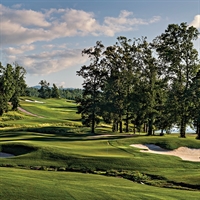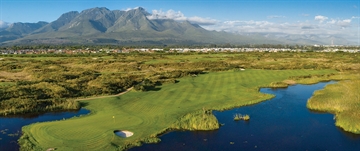A Golfer, By Design
October 30, 2024
Change in golf, like life, does not always come easy. For example, changing a golf swing takes time, effort and the right plan. But changing a public perception requires even more—creativity, commitment and some guts. In an attempt to augment its tourism dollars in the early 1990s, Alabama state tourism bureau officials looked to golf to draw more out-of-state visitors, and now golf travelers from all over the world reap the benefits.
The effort was born out of racial controversy. Public backlash arose surrounding the 1990 PGA Championship at Shoal Creek Golf and Country Club in Birmingham due to the club’s exclusionary membership policies, and the tournament was nearly moved. In the aftermath, the state made a bold commitment to constructing the Robert Trent Jones (RTJ) Golf Trail—an unprecedented effort to build numerous public courses simultaneously throughout the state—and now Alabama is a coveted golf destination for its courses on and off the Trail.
Digging it Out of the Dirt
Although the RTJ Trail traverses the length and breadth of Alabama, its origin has roots in Minnesota. Dr. David G. Bronner (who grew up in Austin, Minnesota, and graduated from then-Mankato State University) has been CEO of the Retirement Systems of Alabama for 50 years, and in 1990 was looking for a way to diversify the investment of state retirement funds—and help rehabilitate the state’s image through golf. He became motivated by the famous “Field of Dreams” quote, “if you build it [they] will come,” and sought out a big-name course architect to build his “links of dreams.”
Bronner’s idea of building numerous public courses at the same time was laughed at by some architects—and turned down by both Arnold Palmer’s and Jack Nicklaus’ design firms—as he crisscrossed the state searching for suitable sites and acquiring land. But Robert Trent Jones, Sr., nearing the end of his career, signed on to the project, which opened with seven golf facilities in 1992. With Jones in failing health, his longtime associate Roger Rulewich did a lot of the design on the fly, formulating the holes to what the landforms offered and creating a vast array of unique golf.
“Most of it was site design. We would drive from site to site, designing holes as we went,” Rulewich said in The Trail Guide 25, a quarter-century anniversary publication. “It might sound crazy, but it was the greatest way in the world to work. It was very free-form.”
Between 1992 and 1993, all 11 Trail sites opened their doors, and they now include 26 courses with 468 holes. Since that time, numerous other non-Trail, high-end public courses have sprung up across Alabama to take advantage of all the visitors (see page 18). Now in its 31st year, the Trail courses host half a million rounds per year, with 50% of them played by golfers from outside the state.
“All of these people, many of them golfers, were driving like hell through Alabama, mostly going to Florida,” Bronner told the anniversary publication. “Our mission was to divert them. So far, I think, we’ve done pretty well.”
Trail Mix
The RTJ concept was unique for its time (inspiring other such “trails” in its wake), yet executed brilliantly. The Trail attracts significant tourism beyond golf (see sidebar) and has helped change the state’s image to one of welcoming hospitality. The Trail courses spread from the northern border of the state to the southern Gulf Coast, averaging a 1.5- to 2-hour drive time between locations, and typical green fees (including cart) are $69 ($54 during the summer and winter months). So, the Trail won’t empty your wallet and will make 36 holes per day split between two different locations an achievable goal.
Alabama may surprise the uninitiated with its topography—as verdant valleys, rolling hills and deep woods bracket the byways from the north to the beautiful and shimmering Gulf Coast. An RTJ Trail tour can begin in any region in the state, and ours started at the northernmost course and headed clockwise southeastward. Here’s a sampling of what we found on
the Trail.
The Shoals (Opened 2004)
Hard by the wide and beautiful Tennessee River, The Shoals (located in Florence), with its two impressive championship tracks—Fighting Joe and the Schoolmaster—is the perfect opener to RTJ golf. Fighting Joe tops out at 8,092 yards and offers expansive, manicured fairways and large, true-rolling bentgrass greens to soften the challenge. It’s a long-hitters course (all of 78.6/146 slope rating from the tips) with everything set out in front of the golfer on six sets of tees; the challenge is choosing the right length for reaching your target
to score.
Meanwhile, the Schoolmaster may be a bit shorter in length (7,921 yards), but it’s narrower with more demanding approaches and certainly ratchets up the challenge (77.6/148 slope rating). The views along the way can be breathtaking with a beautiful waterfall guarding the second green and a captivating view of the Tennessee River from the bluffs on No. 18.
Likewise, the expansive vista near the 18th green on Fighting Joe—called by one local with a vested interest “the best view on the RTJ Trail”—should not be missed. It is hard to argue with him as the wide Tennessee River viewed from the clubhouse balcony rolls effortlessly by and belies the frenetic challenge found just
yards away.
Food Science, Space and a Little Rock ‘n’ Roll
In the 1980s’ Twin Cities, Prince, The Time, Jam and Lewis, and others created the “Minneapolis Sound,” but decades earlier another music recording mecca developed in northern Alabama. Artists from all over the world traveled to Muscle Shoals to record their music with the talented local session musicians in search of the “Muscle Shoals” sound.
From Duane Allman sleeping in the parking lot to land a session gig to Keith Richards finishing the lyrics to the Rolling Stones’ “Wild Horses” in the studio bathroom (enshrined as “Keith’s Bathroom”), the small room at 3614 Jackson Highway (now called Muscle Shoals Sound Studio) resonates with rock history like amplifier buzz hanging in the air after a final note. Photos of Mick Jagger, Paul Simon, Linda Ronstadt, Lynyrd Skynyrd, Cher, Willie Nelson and Bob Seegar and their framed records adorn walls surrounding the piano Leon Russell played when recording his classic “Carney” album. Muscle Shoals’ recording history is a must for all rock ‘n’ roll fans.
In Huntsville, visitors can take another historical (virtual) ride—to outer space. During the 1950s, the U.S. Space & Rocket Center was created in Huntsville, and the country’s space program essentially got off the ground. Rockets were developed that put the first U.S. satellite into orbit and sent men to the moon. The Saturn V moon rocket, which carried the Apollo modules to the lunar surface, is displayed in full, not far from an actual moon rock.
The space history is fascinating to explore, especially since it is ongoing. The center (also home to a world-renowned educational program, Space Camp) has developed modules for the International Space Station and is working on a future ship—the Space Launch System. The experience is out of this world.
Down the road in Auburn, you can find something more down-to-earth: the Tony and Libba Rane Culinary Science Center in the College of Human Services on the Auburn University campus. The center, which helps develop our newest generations of cooks, chefs and hospitality professionals, also houses the Hey Day Market Food Hall where you’ll find fresh coffee and pastries, a new beer from the microbrewery and great views of the campus from the rooftop bar of the Laurel Hotel and Spa.
A little music, creative cuisine and a tour to outer space are just some of the unique, can’t-miss tourist stops in Alabama.
Hampton Cove (1992)
One of the original seven RTJ sites, Hampton Cove now features 54 holes across three courses meandering through the low and highlands of the area. Each of the three courses has its own distinct personality. The Highlands (7,428 yards; 76.2/143), boasting vistas on par with the Shoals’, traverses the rolling terrain through long, waving grasses and bentgrass greens. The picturesque old mule barn that perfectly frames the fifth hole will likely end up in a frame on your mantle for a quick mental trip back to the Trail.
The River course snakes through the lowlands of former soybean fields of the Flint River flood plains. Water is a theme, as it comes into play on 16 holes of this fun and playable track. It is known as the only RTJ course in the world designed without a bunker, but with all the water (threatening occasionally on both sides of the fairway), a little sand might be a welcome relief. Hit it straight, and the River course (7,668 yards; 77.5/140) can be managed.
The Short Course (3,635 yards; par 54) is “links-like and open” and has water in play on 11 of 18 holes. It features four sets of tees, and with the forward Teal tees set at 1,861 yards, players of all skill levels can enjoy golfing at Hampton Cove.
Off-Trail Excursions
Appalachian Trail hikers are known to leave the trail for a time (for food, rest or, perhaps, laundry), but in Alabama, you can leave the RTJ Trail and discover more incredible golf—and FarmLinks at Pursell Farms near Sylacauga is a great sojourn.
Built in 2003, Pursell Farms is nestled in a gorgeous wooded valley that is home to wild turkeys, deer, the occasional bobcat and one longhorn steer grazing near the 3,200-acre plantation’s entrance. The course, FarmLinks, is at once as wide and welcoming (with large, receptive greens) and stout and challenging from the tips as any course you’ll find on the Trail.
Owner David Pursell convinced his father, Jimmy, to build the course to help them sell their state-of-the-art controlled-release fertilizer (by hosting more than 10,000 superintendents at the beautiful resort). The course turf once featured 28 different varieties of grass to showcase their products, and FarmLinks’ generous fairways are the result.
Pursell favors downhill par 3s, and the course features several exciting examples, including the 210-yard (from the tips) No. 5 that features a 175-foot roller-coaster-ride drop to the putting surface. FarmLinks (7,444 yards; 75.9/142) has been ranked by Golfweek as the #1 All-Access golf course in Alabama for 11 of the past 12 years.
Pursell Farms hosts weddings, features finely-appointed lodging (the cabins and cottages are decorated with David’s drawings—some of which also hang in Butler Cabin at Augusta National), a spa and a target shooting range run by Orvis. It is an incredible vacation destination. So, with 3,200 acres of land, why not a second course?
“There are no current plans, but I have envisioned one,” Pursell says. “And, I will say, most of the things I envision have a way of coming to fruition.”
Another course worth a Trail exit is Twin Bridges Golf Club in Gadsden, a true escape into the natural Alabama environment. Built along the Coosa River, Twin Bridges is enrolled in the Audubon Silver Signature Sanctuary program, and the natural beauty that implies envelops a golfer. But don’t be too distracted as water is in play on 11 holes. There are seven sets of tees to help visitors find their sweet spot for taming this wild and beautiful 6,734-yard course.
Still have more swings left in you? Head to the Gulf Coast to unearth even more Alabama golf gems on your next trip south.

Grand National (1992)
There are plenty of challenges to that Silver Lakes “best course” claim, and Grand National, voted the No. 1 public golf facility in the country by Golf World readers, has to be in the running. In fact, RTJ, upon first setting eyes on the area, said it was the single greatest natural site for building a golf course he had ever seen. Jones did not fail in bringing the golf out of it. Grand National is home to three courses totaling 54 holes. The Links course (7,404 yards; 75.2/142) is a course with big shoulders. Elevated tees leading to large, raised undulating greens guarded by expansive, facing bunker complexes make the views from the tees and fairways both exciting and intimidating.
The entire Grand National facility is built along the 600-acre Lake Saugahatchee, and the Lake course (7,314 yards; 73.9/132), perhaps, benefits the most. With 12 holes hugging the lake shore it well-earns its moniker. Known for its four par 3 holes, the jewel among them is the 230-yard 15th with a memorable island green. And don’t overlook the Short Course (3,126 yards; par 54), with more than half its beguiling par 3s touching the lake.
Grand National is grand indeed, and its location near the Georgia border makes for a nice trip-ender before the 90-minute drive to the Atlanta airport hub. Get used to the drive—with all these great courses, you will be back to tour another leg of the Robert Trent Jones Trail or more Alabama golf. It’s a game-changer.

October 30, 2024

October 30, 2024

October 30, 2024
Contact Us
Have a question about the Minnesota Golf Association, your MGA membership or the contents of this website? Let us help.